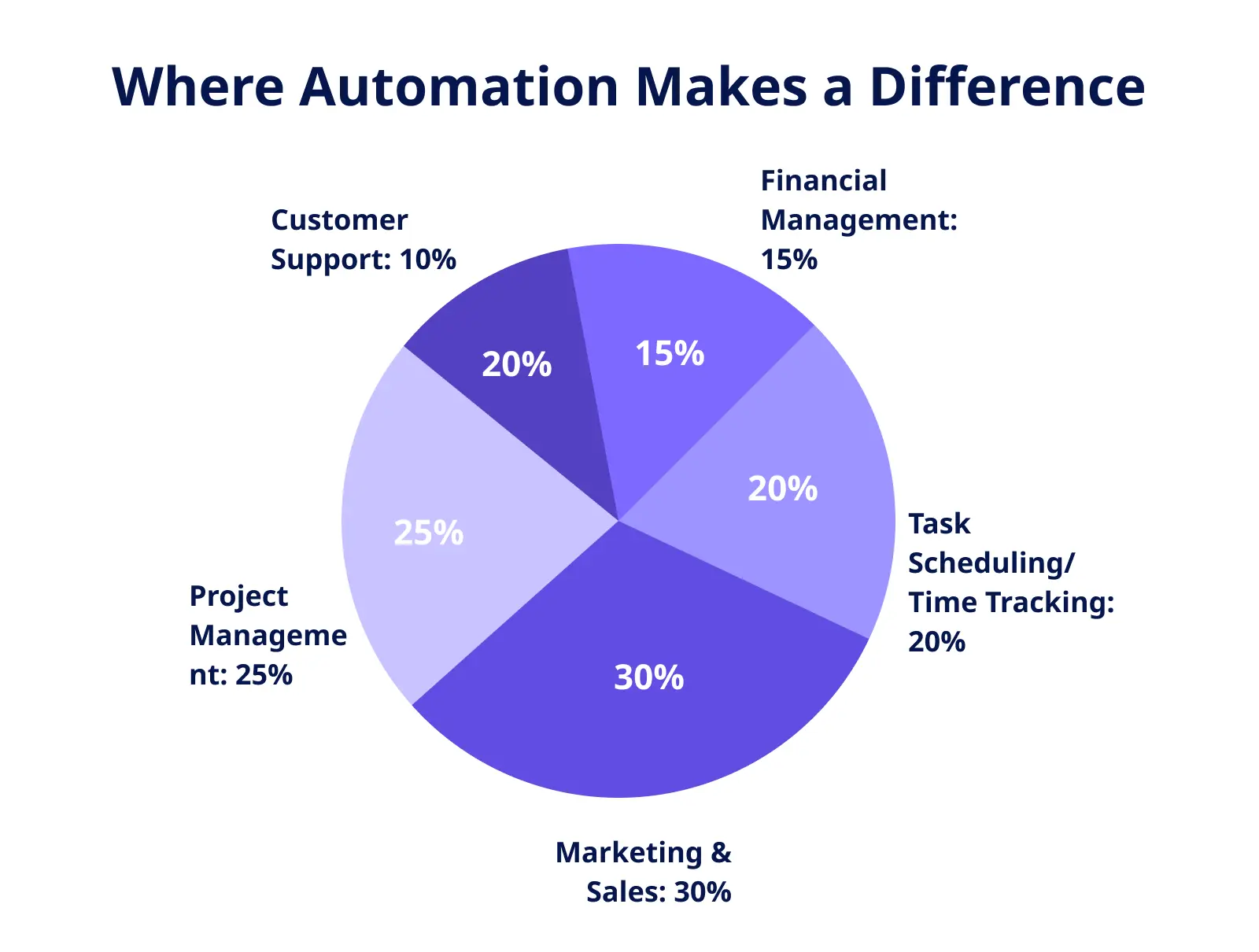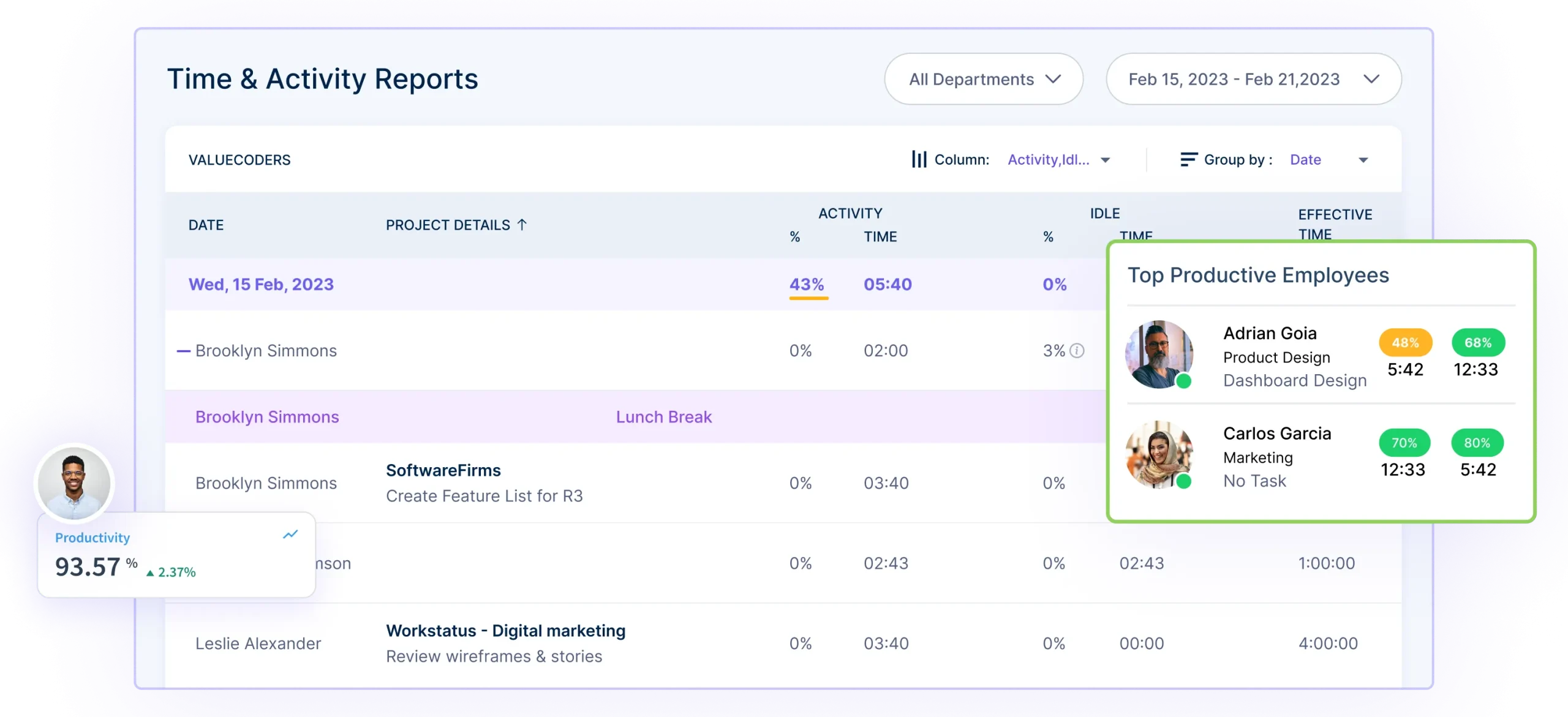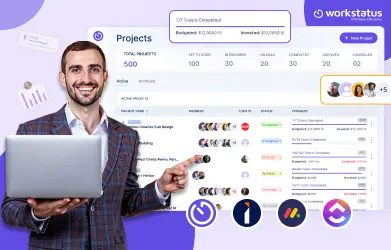Table of Contents
Let’s face it; as a project manager, you’re likely to have more on your head than a restaurant that has prepared food during lunch break and is ready to be served.
From multitasking to coordinating with individuals and organizing work, it sometimes seems we are juggling all the time as if all those plates in the air would suddenly crash down at any moment.
Wouldn’t it be great if some of those plates could be spun by themselves? This is where automation steps in to save the day like some new superhero you wish you had.
A recent Deloitte report states that more than 50% of businesses intend to adopt automation and artificial intelligence (AI) by 2026.
So, it’s time to eliminate numerous, monotonous activities, thousands of emails with follow-ups, and late project changes.
Like your dependable sidekick, automation handles the tedious, repetitive duties so you can concentrate on what counts—guiding your team to success.
Wondering how many tasks you can cross off your daily to-do list thanks to automation? Let’s dive in!
Common Challenges Faced by Project Managers
Here are common challenges faced by project managers:

Balancing Multiple Projects
Juggling multiple projects can feel like riding a unicycle while juggling flaming swords—one wrong move, and chaos ensues! Deadlines and objectives lead to information overload.
- Impact: Missed details and deadlines result in delays and compromised quality.
- Solution: Use automation tools to streamline management and keep tasks prioritized.
Resource Allocation
Finding the right people for tasks resembles musical chairs, with everyone fighting for the best seat. Overcommitting or underutilizing resources is inefficient.
- Impact: Poor allocation leads to delays and overworked teams.
- Solution: Automate resource scheduling for optimal utilization.
Unclear Project Objectives
When project goals are unplanned, confusion reigns. A project may be delayed by stakeholder miscommunication.
- Impact: Lack of clarity causes delays and scope creep.
- Solution: Keep objectives transparent and hold regular check-ins to align everyone.
Scope Creep
Scope creep sneaks in additional tasks without changing the budget or timeline, like ordering a small coffee and getting a venti!
- Impact: Projects become complex, timelines stretch, and costs increase.
- Solution: Set clear boundaries and a change management process to prevent scope creep.
Time Management
Managing your time feels like spinning plates on a rollercoaster with endless meetings and tasks clamoring for attention.
- Impact: Poor time management leads to missed deadlines and burnout.
- Solution: Use time-tracking software and prioritize tasks effectively.
Maintaining Team Collaboration
Coordinating across teams or time zones can feel like herding cats. Keeping everyone aligned is tough.
- Impact: Miscommunication leads to misunderstandings and missed deadlines.
- Solution: Use collaboration tools to enhance communication and teamwork.
Now that you know these challenges, let’s explore automation to streamline business operations!
How Automation Saves The Day?
Automation is a process that involves utilizing technologies to perform specific tasks with minimal or no input from workers. It enables the automation of business operations or complicated actions and increases the speed and accuracy of business processes.
When it comes to businesses, automation technology can be integrated into almost every aspect of running a business, such as project management, managing, analyzing, communicating, and reporting resources.
Project managers who implement the right project management skills and automation tools are 32% less likely to face budget overruns, helping keep projects on track financially.
It is always advantageous when processes can be executed mechanically, leaving little room for error and taking time from workers who should focus on value-added activities. Hence, productivity within the business grows.
Examples of Automation in Business Operations:

Key Areas Where Automation Can Optimize Business Operations
Here are the key areas where automation can optimize business operations:
Project Management
Automation in Action: Automatically assign tasks, set timelines, and update statuses, ensuring nothing is overlooked.
Benefit: Save time on coordination and track projects effortlessly.
Task Scheduling and Time Tracking
Automation in Action: Tools like Workstatus schedule tasks based on availability and track work hours without constant check-ins.
Benefit: Enjoy accurate tracking, balanced workloads, and a productivity boost.
Marketing and Sales
Automation in Action: Email platforms send campaigns based on customer behavior, while CRMs track leads automatically.
Benefit: Enhance lead generation and customer engagement effortlessly.
Financial Management
Automation in Action: Tools like Invoicera, Freshbooks, etc., automate invoicing and expense tracking, simplifying financial processes.
Benefit: Reduce errors, speed up cash flow, and keep finances transparent.
Customer Support
Automation in Action: Chatbots handle routine queries, providing instant support around the clock.
Benefit: Improve response times and customer satisfaction while easing the workload on support teams.
Inventory and Supply Chain Management
Automation in Action: Systems track stock levels and manage real-time logistics.
Benefit: Smooth operations, reduce costs, and prevent stock issues.
Human Resources
Automation in Action: Streamline onboarding, payroll, and performance evaluations, eliminating paperwork.
Benefit: Save time, reduce errors, and improve employee satisfaction.
Data Reporting and Analytics
Automation in Action: Tools automatically generate reports and insights—no confusing terminology required!
Benefit: Enhance decision-making and forecasting with less manual effort.
Automation streamlines critical business operations, transforming chaos into order and making work more efficient!
Common Misconceptions About Automation
Here are some common misconceptions about automation with reality:
Automation Replaces Human Jobs
Misconception: Automation is a sci-fi villain that wants to replace all human workers.
Reality: Consider automation a helpful sidekick that handles mundane tasks, freeing employees to tackle complex work that requires brainpower.
Automation Is Only for Large Enterprises
Misconception: Automation is an exclusive club for big corporations.
Reality: Automation tools are accessible and affordable for businesses of all sizes, like your neighborhood diner—no velvet ropes needed!
Automation Is Too Expensive
Misconception: Implementing automation is like buying a private island—only for the wealthy.
Reality: While some solutions can be pricey, many affordable options let you start small and scale up, just like customizing a pizza; start with cheese, then go wild with pepperoni and olives!
Automation Requires Technical Expertise
Misconception: You need a team of tech wizards to use automation tools. Yikes!
Reality: Most modern tools are user-friendly and intuitive, so even your grandma could set them up while knitting. No tech degree is required!
Automation Makes Work Impersonal
Misconception: Automation turns workplaces cold and robotic.
Reality: Automation can actually enhance personalization by allowing targeted communication, keeping the human touch alive—without the robot hugs!
Automation Is a One-Size-Fits-All Solution
Misconception: Automation tools are generic and fit all businesses the same way.
Reality: Automation is customizable, tailored to fit your business’s unique needs—no more potato sacks!
Next time automation comes up, you can debunk these myths with a smile. It’s all about making work more accessible and efficient! Who wouldn’t want that?
Benefits of Automation for Project Managers
Here are the key benefits of automation for project managers:

Workstatus as the All-in-One Automation Tool for Project Managers
Imagine if a project manager had a magic wand to make tracking and managing projects as easy as ordering pizza.
That’s what Workstatus is—minus the wand, but packed with automation magic.
It handles everything from keeping an eye on the team (no actual spying involved) to figuring out who’s been slacking off (with love, of course).
Real-time Project Tracking
![]()
Keep tabs on your project in real time without hovering over your team like a helicopter. With Workstatus, you get up-to-the-minute updates on tasks, milestones, and deadlines, so you’ll always know if things are on track or about to derail. No crystal ball is required!
AI-powered Productivity Reports

Let AI handle the number crunching! Workstatus generates thoughtful, AI-powered productivity reports that give insights into the team’s performance. It’s like having a personal assistant who loves data and never sleeps.
Comprehensive Time Tracking
![]()
Time is money, and Workstatus makes sure you track every second. With comprehensive time tracking, you’ll know exactly where time is spent (or wasted). Whether on projects or endless snack breaks, Workstatus has you covered.
Automated Resource Management

Why manually manage schedules when you can automate them? Workstatus helps you manage your resources without the headache. It ensures you’re using your team’s time efficiently, balancing workloads, and avoiding burnout—because happy teams are productive teams!
Employee Activity Tracking
![]()
Curious about what your team’s actually up to? Workstatus offers non-intrusive employee activity tracking so you can see who’s working hard and who’s got Netflix in the background (you know who you are). It’s productivity tracking without the creepy vibes.
Geofencing and Location Tracking
![]()
For teams on the move, Workstatus uses geofencing and location tracking to ensure you know where everyone is, whether they’re working remotely or on-site. No need to play “Where’s Sam?”—you’ll have complete visibility with just a glance.
Steps to Implement Automation in Business Operations
Here are the prominent steps to implement automation in your business operations:

Identify Areas for Automation
Take a good look at your business processes. Where can automation save you from drowning in spreadsheets? Think of it as hunting for the last piece of pizza at a party—what’s most valuable?
Set Clear Goals
Define your objectives. Are you aiming to impress your boss, reduce errors, or finally find time to binge-watch your favorite series? Clear goals will guide you like a GPS, minus the annoying voice.
Choose the Right Tools
Research automation tools that fit your needs. It’s like dating—find a user-friendly, scalable match who won’t ghost you after a month! Just don’t pick the most expensive option, thinking it’s the best—remember, diamonds aren’t necessary for automation.
Create a Detailed Plan
Develop a roadmap that outlines your automation journey. Think of it as a treasure map, except instead of gold, you’re digging for efficiency and time savings (pirate hat optional).
Engage Your Team
Involve your team in the automation process. Host a “team brainstorming” session that may or may not include snacks. Addressing concerns and gathering input is essential—no one wants a mutiny on the ship!
Start Small
Begin with a pilot program or automate a single process. It’s like testing a new recipe; you wouldn’t serve burnt cookies to guests, right? Start small, gather feedback, and refine your skills before moving on to the main course.
Monitor and Evaluate
Keep an eye on your newly automated processes. Use analytics to see if you’re hitting your goals. Think of it as your trainer—nobody wants to see those sad numbers!
Iterate and Improve
Make adjustments based on feedback. If the process isn’t working, don’t be afraid to pivot. It’s like dance—sometimes you must switch steps to avoid stepping on toes!
Scale Up
Once you’ve nailed the initial automation, expand it to other business areas. It’s time to unleash your inner automation guru—just remember to keep your cape in the closet!
Stay Updated
Keep up with the latest automation trends and technologies. Think of yourself as an incredible tech-savvy wizard casting spells of efficiency. Remember, the magic of automation never stops evolving!
Closing Thoughts
To sum up, automation can be described as the magic wand for your business—all the tedious work is done for you, so you can spend that time reading the essential business events and trends or simply contemplating with the second cup of coffee.
Everything is automated, from project management to complete customer support and tracking inventory; therefore, there is no more stress about such matters.
Almost 97% of businesses agree that automating business processes is important for digital transformation.
For anyone ready to automate their business but do not know where to start, Workstatus is your go-to solution. In effect, it seems like having an efficiently performing virtual personal assistant specializing in time allocation of tasks and efficiency enhancement without a single break for coffee!
So why not try automation and watch your business run smoother than ever?
More productivity and a hassle-free day at the office? Well, now that’s a combo that can only be celebrated!
FAQs
Ques. Which business processes can be automated to improve efficiency?
Ans. Automating tasks like time tracking, payroll, invoicing, customer service, marketing, data entry, and project management can free up resources and streamline operations for any business.
Ques. How can automation tools help in project management?
Ans. Automation tools automate progress tracking, task assignments, deadline reminders, and reporting, freeing project managers to focus on strategy and collaboration.
Ques. Is automation suitable for small businesses, or is it more for large enterprises?
Ans. Automation benefits businesses of all sizes. Small businesses can gain a competitive edge by optimizing resources, reducing manual work, and boosting productivity. Many tools offer scalable options to grow your business.












